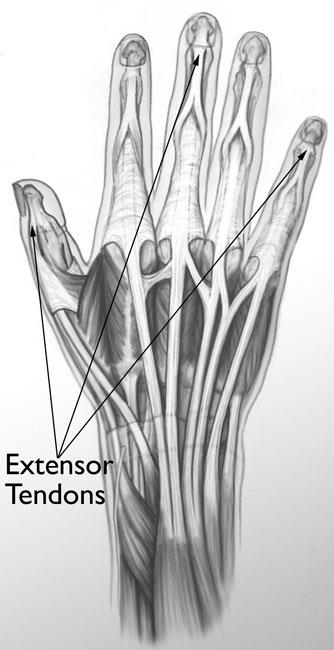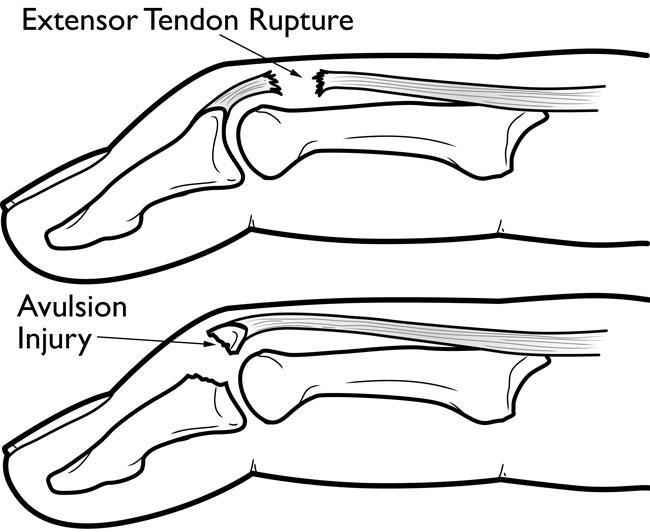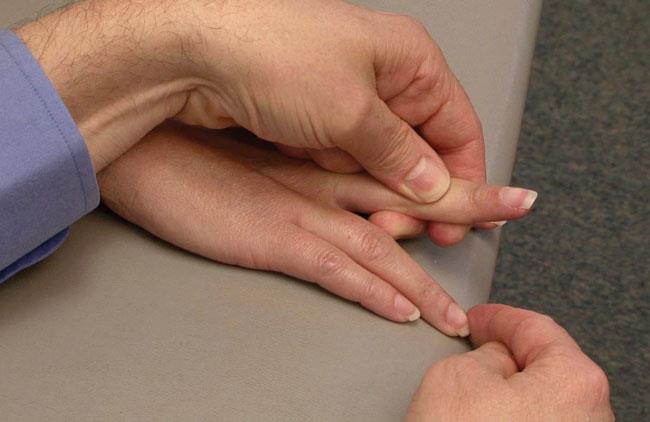Diseases & Conditions
Mallet Finger
Mallet finger is an injury to the thin tendon that straightens the end joint of a finger or thumb. This joint is called the distal interphalangeal (DIP) joint in the fingers and the interphalangeal (IP) joint in the thumb.
The injury can happen when an unyielding (rigid or solid) object (like a baseball) strikes the tip of a finger or thumb and forces it to bend further than it is intended to go. As a result of the injury, you are not able to straighten the tip of your finger or thumb on your own, resulting in a bent posture of the tip of the digit.
Anatomy
Tendons are tissues that connect muscles to bone. The muscles that move the fingers and thumb are located in the forearm and hand. Tendons extend from these muscles through the wrist and attach to the small bones of the fingers and thumb, allowing you to move them.
- The extensor tendons on the top of the hand straighten the fingers.
- The flexor tendons on the palm side of the hand bend the fingers.
Description
In a mallet injury, when an object hits the tip of the finger or thumb, the force of the blow causes a tear near the insertion (attachment) of the extensor tendon at the last joint of the digit. While the force to cause this injury is typically large, a minor force, such as tucking in a bed sheet, will sometimes cause a mallet finger.
The injury may either rupture the middle of the tendon or pull the tendon away from the place where it attaches to the finger bone (distal phalanx). In some cases, a small piece of bone is pulled away along with the tendon. This is called an avulsion injury. Sometimes, the avulsion fracture can be quite large and cause instability of the affected joint. In those cases, surgery may be needed.
The long, ring, and small (pinky) fingers of the dominant hand are most likely to be injured. However, any digit can develop a mallet.
Symptoms
- The finger is usually painful, swollen, and bruised.
- The fingertip will droop noticeably.
- The fingertip will straighten only if you push it up with your other hand.
Risk for Infection
It is very important to seek immediate attention if there is blood beneath the nail or if the nail is detached. This may be a sign of a cut in the nail bed, or that the finger bone is broken and the wound penetrates (extends) down to the bone (open fracture). These types of injuries put you at risk for infection.
First Aid
- To relieve pain and reduce swelling, apply ice to your finger immediately and keep your hand elevated above your heart.
- Acetaminophen or non-steroidal anti-inflammatory drugs (NSAIDs), like ibuprofen and naproxen, may help with the pain.
- You can create a well-padded splint for the tip of the digit, but make sure the splint is not so long that it prevents motion of the uninjured joints.
- Seek an evaluation with a hand surgeon as soon as possible, ideally within a week of the injury.
Doctor Examination
A mallet finger injury requires medical treatment to ensure the finger regains as much function as possible. Most doctors recommend seeking treatment within a week of the injury. However, there have been cases in which treatment was delayed for as long as a month after the injury and the finger still healed completely.
Physical Examination
After discussing your medical history and symptoms, your doctor will examine your finger or thumb. During the examination, your doctor will hold the affected finger and ask you to straighten it on your own. This is called the mallet finger test.
X-rays
Your doctor will most likely order X-rays of the injury.
If a fragment of the distal phalanx was pulled away when the tendon ruptured, or if there is some other larger fracture of the bone, it will appear in an X-ray.
An X-ray will also show whether the injury pulled the bones of the joint out of alignment, which may require surgery to correct.
Treatment
Mallet finger injuries that are not treated properly typically result in stiffness and deformity of the injured fingertip. In the worst-case scenario, untreated mallet finger can result in significant deformity and poor function (swan neck deformity).
However, when treated promptly, the majority of mallet finger injuries can be treated without surgery, with a splint.
In children, mallet finger injuries may involve the cartilage that controls bone growth. A doctor must carefully evaluate and treat this injury in children, so that the finger does not become stunted (not properly developed) or deformed.
Nonsurgical Treatment
Most mallet finger injuries are treated with splinting. A splint holds the fingertip straight (in extension) until it heals.
To restore function to the finger, the splint must be worn full time for 6 to 8 weeks. This means that it must be worn while bathing, then carefully changed afterward. However, the splint can be removed for bathing if the DIP joint (finger) or IP joint (thumb) is held straight with the other hand the entire time the splint is off. If the fingertip droops at all, healing is disrupted, and you will need to wear the splint for a longer period of time.
Because wearing a splint for a long period of time can irritate the skin, your doctor may talk with you about how to carefully check your skin for problems. Your doctor may also schedule additional visits over the course of the 8 weeks to monitor your progress.
For 3 to 4 weeks after the initial splinting period, you will gradually wear the splint less frequently — perhaps only at night. Splinting treatment usually results in both acceptable function and appearance; however, many patients do not regain full fingertip extension.
For some patients, the splinting regimen is very difficult. In these cases, the doctor may decide to insert a temporary pin across the fingertip joint to hold it straight for 8 weeks.
Surgical Treatment
Your doctor may consider surgical repair if there is a large avulsion fracture fragment, or the joint is out of line (subluxed). In these cases, surgery is done to repair the fracture and realign the joint using pins to hold the pieces of bone together while the injury heals.
As mentioned above, surgery may also be considered if you are unable or unwilling to wear a splint for 8 weeks. Pinning the joint straight acts like an internal splint; however, this comes at the cost of increased risk for complication with surgery.
If there is no fracture and the joint is well-aligned, it is not common to treat mallet finger with surgery. The tendon is very thin, and repairs with suture are difficult, if not impossible. Tendon grafts — taking tendon from another part of the body and applying it to the damaged finger — are challenging and not always effective. Thus, splinting is usually the treatment of choice.
In a chronic mallet finger (the injury is several months or years old), fusion of the joint may be considered. A joint fusion removes the movement in the joint and positions it in a permanent, useful position. For the DIP and IP joints, the fusion is often done fairly straight for appearance and function.
Outcomes
Regardless of treatment, most patients with mallet finger have a good outcome when properly and promptly treated.
Last Reviewed
May 2023
Contributed and/or Updated by
Peer-Reviewed by
AAOS does not endorse any treatments, procedures, products, or physicians referenced herein. This information is provided as an educational service and is not intended to serve as medical advice. Anyone seeking specific orthopaedic advice or assistance should consult his or her orthopaedic surgeon, or locate one in your area through the AAOS Find an Orthopaedist program on this website.









